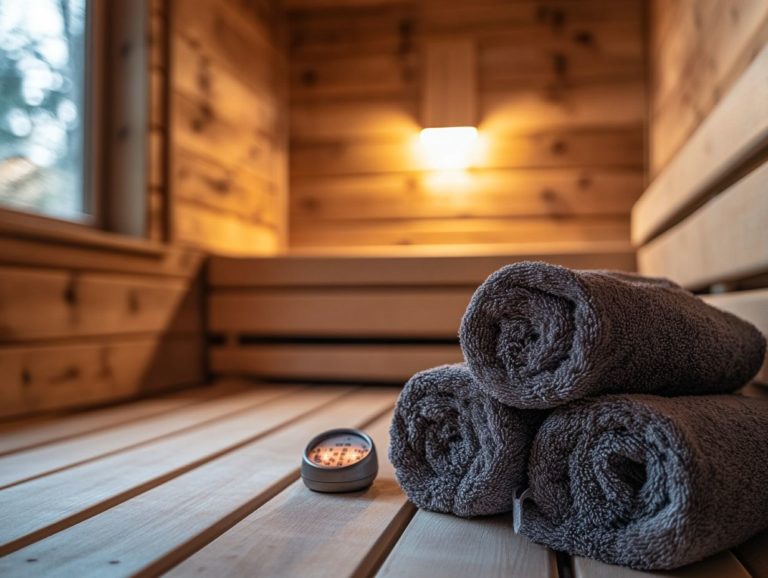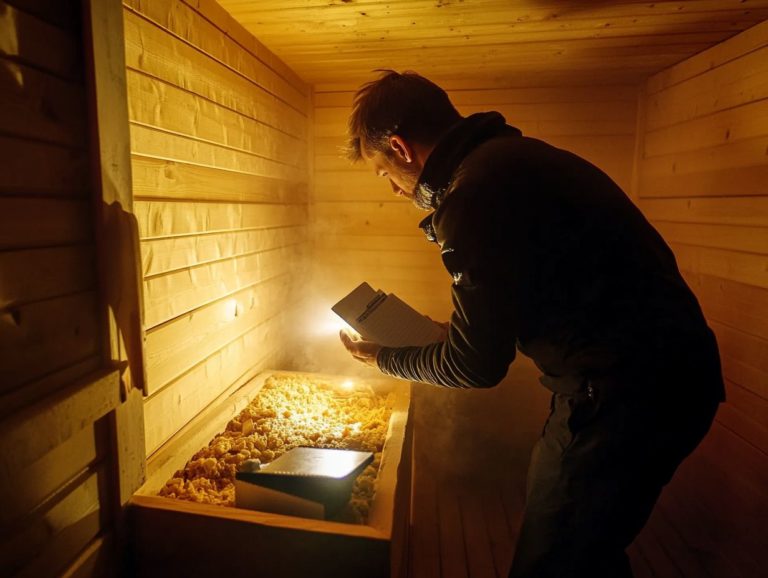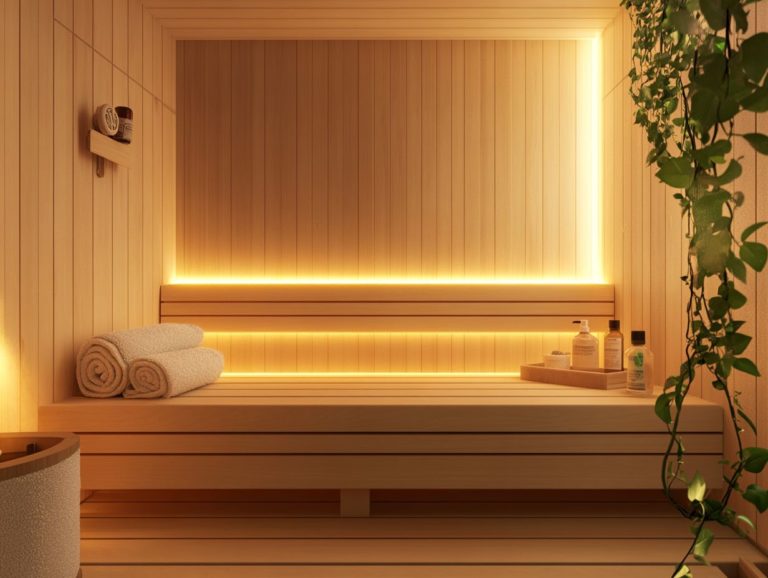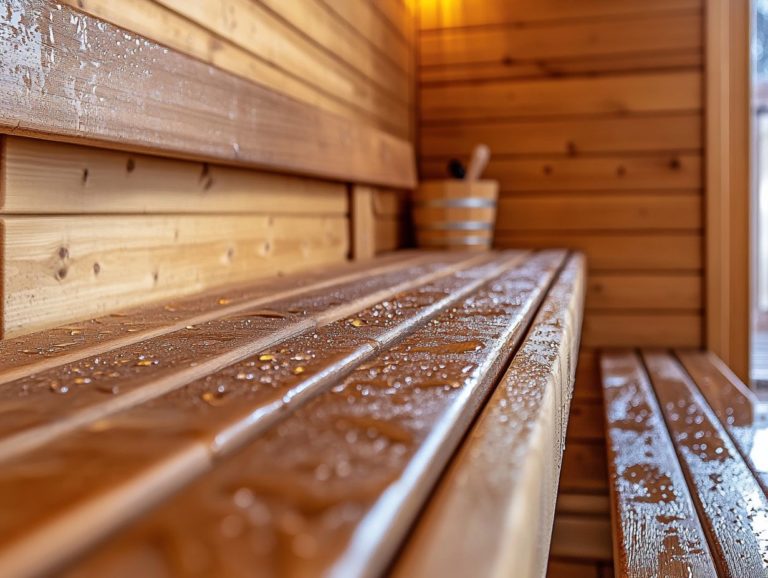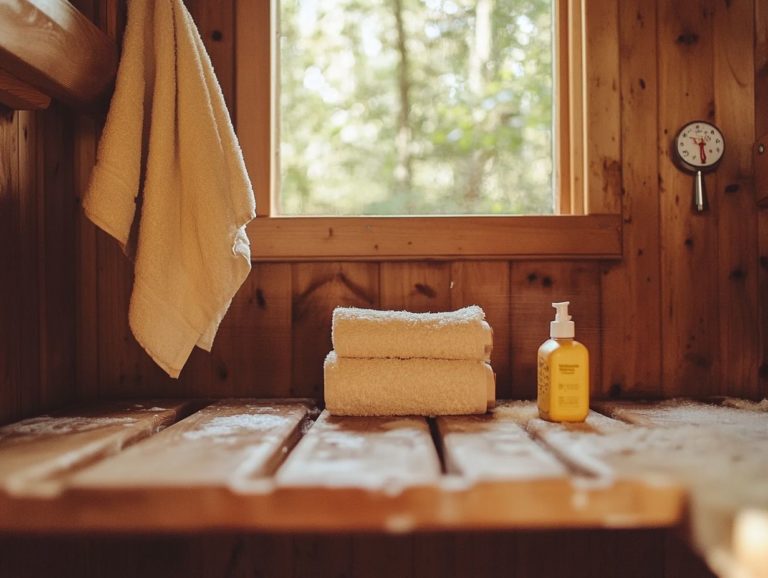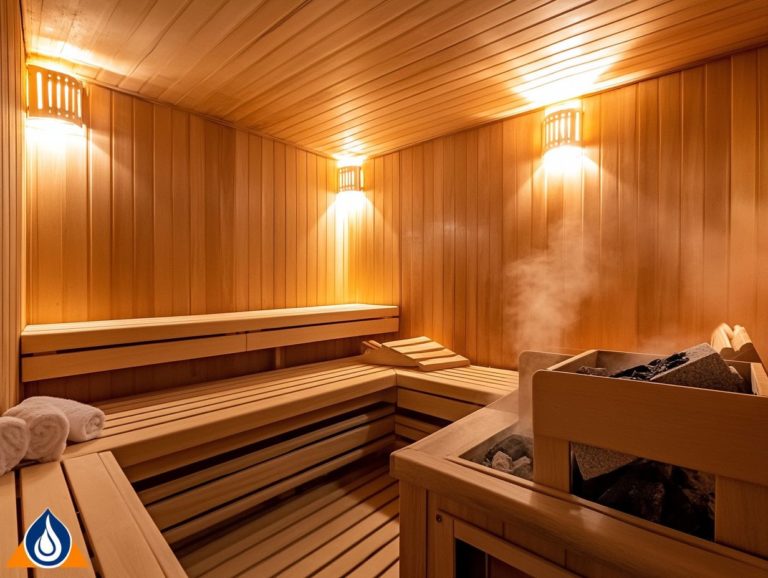Tips for Maintaining Your Sauna’s Exterior
Maintaining your sauna’s exterior is essential for beauty and longevity. Just as the warmth within provides comfort, a well-cared-for exterior elevates your sauna experience and safeguards your investment. Regular care and cleaning are vital to ensure your sauna remains a personal retreat.
This article delves into the different types of sauna exteriors, from wood to tile, and offers vital maintenance techniques specific to each material. You ll also find insights into common issues you might face, along with preventive measures to keep your sauna looking impeccable. This ensures a durable and enjoyable experience.
Keep your sauna as a tranquil retreat for years to come! Regular inspections and proper placement of sauna accessories can greatly enhance your experience.
Contents
- Key Takeaways:
- Why Maintaining Your Sauna’s Exterior is Important
- Common Types of Sauna Exteriors
- Recommended Maintenance Techniques for Each Exterior Type
- Troubleshooting Common Exterior Issues
- Preventive Measures for Maintaining Your Sauna Exterior
- Frequently Asked Questions
- Essential Tips for Maintaining Your Sauna s Exterior
- How often should I clean my sauna’s exterior and maintain its surfaces?
- Can I use any type of cleaner on my sauna’s exterior?
- What is the best way to protect my sauna’s exterior from moisture and temperatures?
- Should I be concerned about cracks in my sauna’s exterior and the impact of excessive heat?
- Do I need to cover my sauna, including the benches and sauna cushions, when it is not in use?
Key Takeaways:
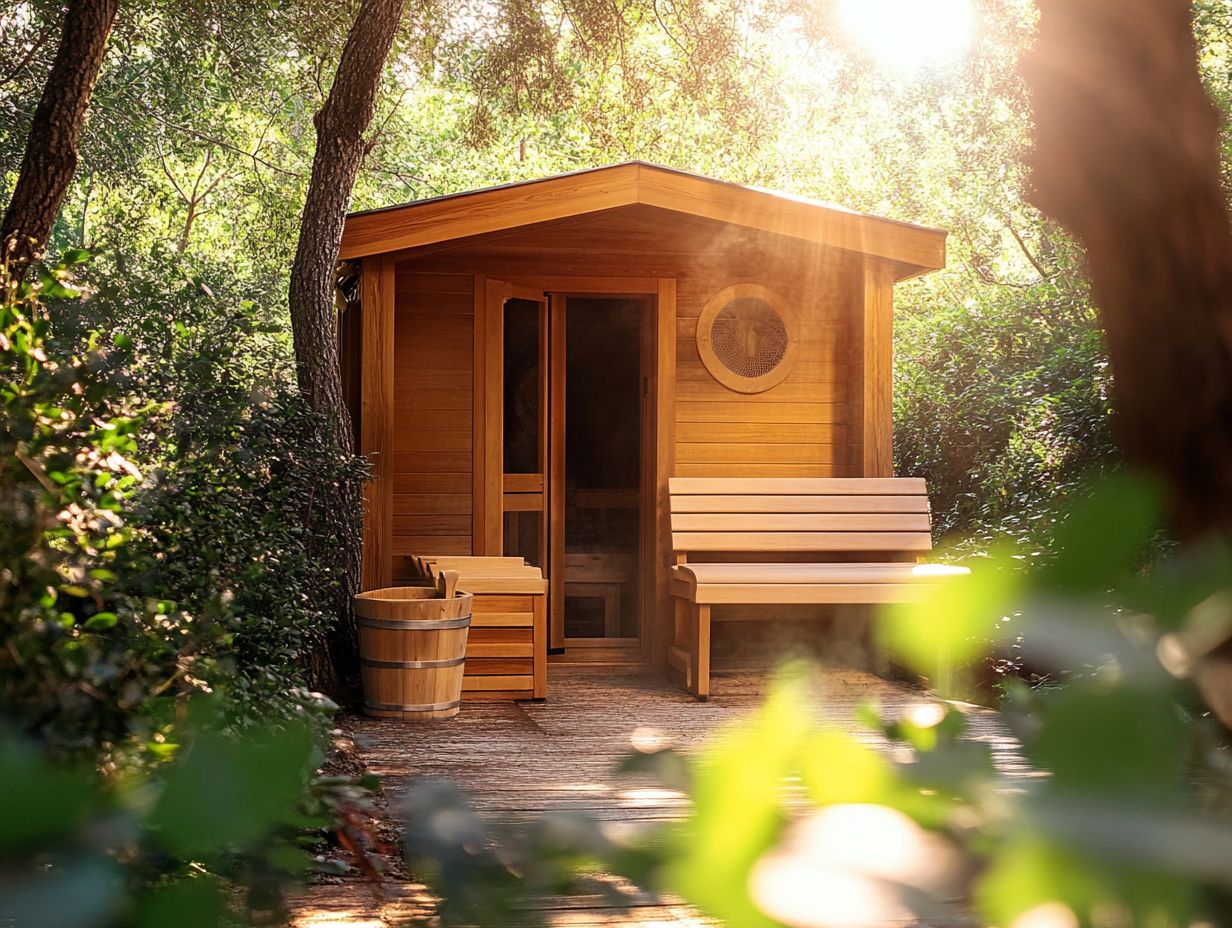
- Regular maintenance is crucial for your sauna’s longevity.
- Wood and tile require specific care techniques.
- Sealing and protecting the exterior can maintain overall condition.
Why Maintaining Your Sauna’s Exterior is Important
Maintaining your sauna’s exterior is essential for preserving its longevity and functionality, particularly for outdoor models that face the whims of the weather. Proper upkeep not only enhances the wood’s aesthetic appeal but also safeguards against water damage, which can lead to mold and mildew. This ensures a safe and enjoyable experience for everyone, especially when using essential oils to enhance the atmosphere.
Regular maintenance of surfaces, including periodic cleaning with suitable agents, is vital for keeping the wood grain intact, preventing unsightly stains, and ensuring your sauna remains a durable sanctuary for relaxation and rejuvenation. Using a mild detergent mixed with warm water works effectively.
The Role of Exterior Maintenance in Sauna Longevity
Exterior maintenance is vital for your sauna’s longevity. It directly influences the durability and aesthetic appeal of the various wood types used in its construction.
Regarding selecting wood for your sauna, options like Western Red Cedar and Canadian Hemlock are highly sought after for their unique properties and moisture resistance. Western Red Cedar is resistant to decay and smells great! However, it requires periodic sealing to maintain its vibrant color and ward off water damage.
On the other hand, Canadian Hemlock is strong and stable. However, it may demand more frequent inspections and treatments to combat water exposure and prevent warping. Regular maintenance enhances safety and underscores the importance of caring for these materials to extend the lifespan of your sauna, allowing you to relish its benefits for years.
Common Types of Sauna Exteriors
Understanding the various types of sauna exteriors is crucial for selecting the right maintenance techniques tailored to the material at hand. Whether you re working with wood, tile, or other construction materials, each option presents its own unique benefits and challenges.
For outdoor saunas, specific wood types like European spruce or Western Red Cedar are often favored for their moisture-resistant qualities. Indoor saunas may feature tiles that enhance aesthetic appeal and make cleaning a breeze. Many of these tiles are easy to clean, simplifying maintenance.
Start inspecting your sauna today to ensure it remains your perfect retreat!
Overview of Wood, Tile, and Other Materials
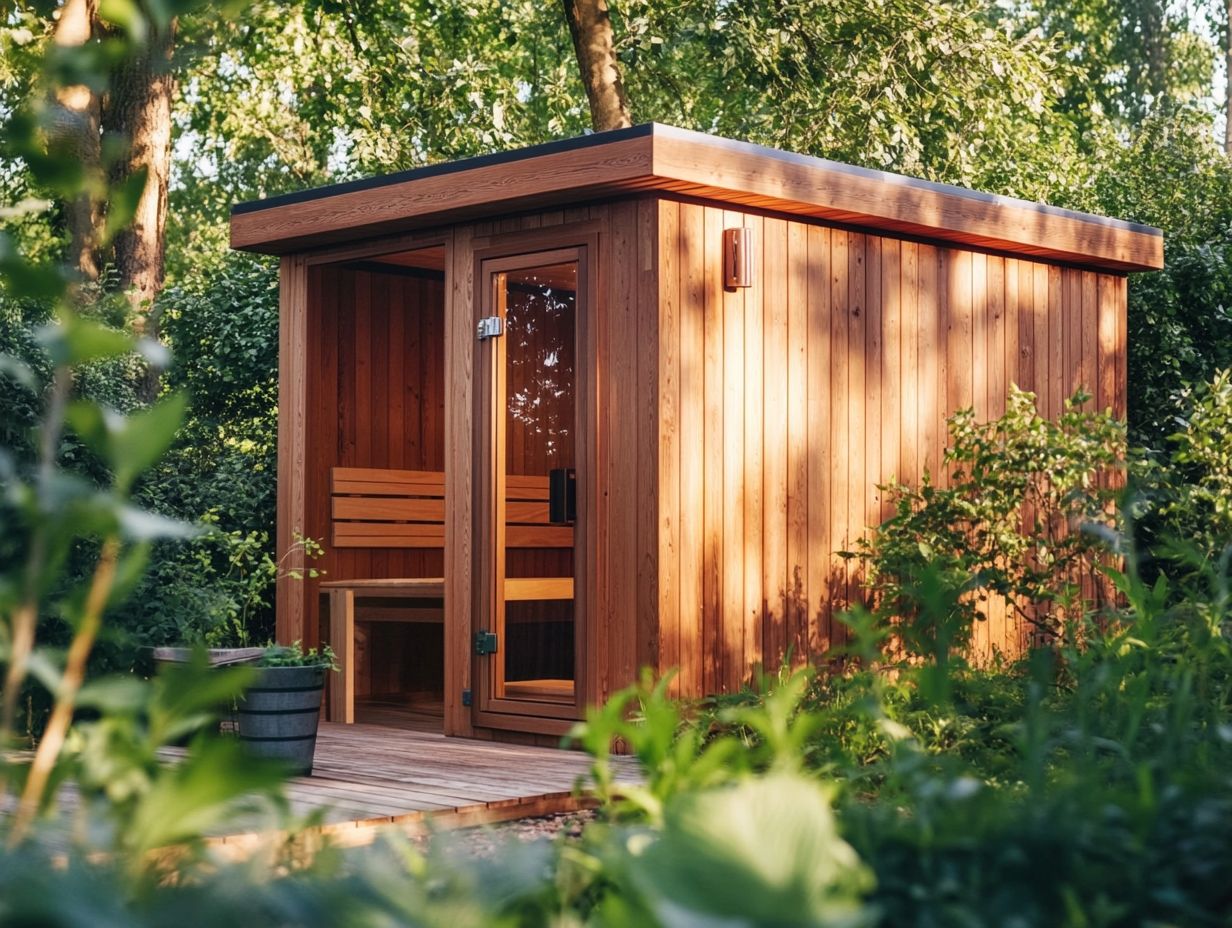
When you look into the materials used for sauna exteriors, you’ll uncover the distinct benefits and drawbacks of each option. Wood often emerges as the traditional favorite, celebrated for its natural aesthetic and moisture resistance.
Tile shines with its ease of cleaning and durability in high temperatures. As you explore choices like Thermory, renowned for its thermal properties and stability, or Tikkurila, appreciated for its deep penetration and protective finish, you ll find yourself carefully weighing your preferences. This is especially important in terms of heat distribution and moisture control.
Each type of wood interacts uniquely with the sauna s elements, affecting air circulation and temperature retention. Thermory helps with effective heat regulation. However, Tikkurila’s finishes might demand more frequent upkeep to combat the humid environment and enhance the durability of your sauna.
Tile offers a non-porous surface, which means lower maintenance, but it may hinder airflow. It s vital to find the perfect balance between aesthetics and functionality in your sauna’s design, ensuring proper ventilation and air circulation.
Recommended Maintenance Techniques for Each Exterior Type
Implementing recommended maintenance techniques specifically designed for each type of sauna exterior is essential for preserving its quality and longevity. This attention to detail ensures that your sauna remains a durable and enjoyable retreat.
Offering you the ultimate experience in relaxation and health benefits through effective moisture management is a worthy goal.
Specific Cleaning and Care Instructions
Specific cleaning and care instructions for sauna exteriors are essential for maintaining the integrity of wooden surfaces and creating a safe environment. It s often recommended to use a mild detergent along with warm water to effectively remove sweat and moisture without harming the materials.
Understanding the specific wood types used in construction, like cedar or hemlock, can help you choose the right cleaning agents tailored for maintaining outdoor sauna materials. For instance, cedar s natural oils repel water, making it more resilient to dampness.
In contrast, hemlock requires a gentler touch to prevent damage. It’s crucial to steer clear of harsh chemicals and abrasive scrubbing tools; these can strip the wood s protective layers and jeopardize its longevity.
Regular maintenance of sauna heaters should include checking for dust and debris accumulation, which can impact both safety and temperature control. Use a soft cloth to gently wipe surfaces, ensuring that any cleaning agent you select is compatible with metal components. This approach not only preserves performance but also prioritizes safety.
Troubleshooting Common Exterior Issues
Navigating common exterior issues in saunas is crucial for preserving both safety and functionality. By proactively identifying and addressing concerns such as moisture damage, mold growth, and surface wear, including the need for proper moisture-resistant treatments, you can prevent these minor problems from escalating into more serious challenges.
Don t wait to address these common issues! Prioritizing this maintenance not only enhances your sauna experience but also protects your investment for the long haul.
Identifying and Addressing Damage or Wear
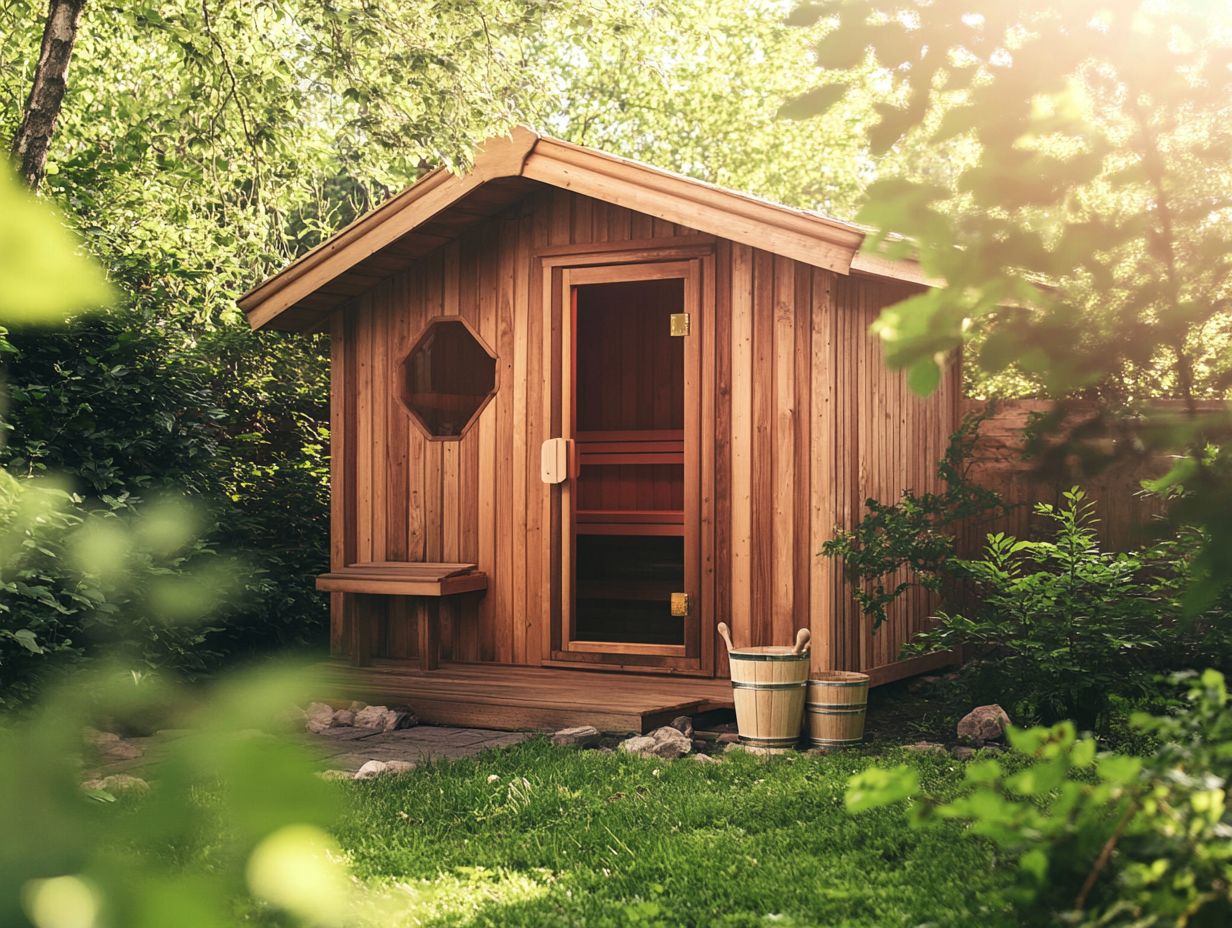
Identifying and addressing any damage or wear on your sauna’s exterior is essential for maintaining its attractive appearance and functionality. Pay particular attention to areas most vulnerable to moisture and heat exposure.
To effectively assess the condition of your sauna, look for signs of deterioration. Discoloration may reveal prolonged exposure to humidity, while splitting wood is a common issue that can jeopardize structural stability. Surface deterioration might also indicate that immediate action is necessary. Regular maintenance, such as applying moisture-resistant treatments these materials help protect your sauna from water damage and ensuring the use of wood preservatives, can significantly extend the life of your sauna’s exterior.
Use gentle cleaning techniques to help you remove dirt and grime without inflicting further damage. This ensures that your sauna remains both stunning and functional for years to come, allowing for a safe and pleasant sauna ownership experience.
Preventive Measures for Maintaining Your Sauna Exterior
By implementing preventive measures for maintaining your sauna’s exterior, you can significantly enhance its durability and aesthetic appeal. This ensures that your outdoor sauna remains a safe and inviting sanctuary for relaxation and rejuvenation, particularly when using comfortable sauna cushions and seat covers.
Tips for Keeping Your Sauna Exterior in Top Condition
To maintain your sauna’s exterior in pristine condition, embrace a comprehensive approach that prioritizes regular care, cleaning, and the use of moisture-resistant materials. Remember to store bath towels properly after each use for both durability and a safe experience.
Adopt a preventive mindset by conducting seasonal inspections to catch any signs of wear or damage before they escalate. This helps ensure the longevity of your sauna’s wooden surfaces. Keeping the exterior clean is straightforward when you choose appropriate cleaning agents that strike the right balance gentle yet effective while avoiding harsh chemicals that could jeopardize your materials.
Integrate a thoughtful cleaning routine, utilizing absorbent towels and soft brushes. Use soft brushes and non-abrasive cloths to gently wipe down surfaces. Don’t forget to employ absorbent towels and personal towels after each use to capture excess moisture, further safeguarding your sauna’s exterior. For additional insights, check out these tips for maintaining your sauna’s electronics. Opting for durable, weather-resistant materials not only prolongs the life of your sauna but also reduces maintenance efforts over time.
Frequently Asked Questions
Essential Tips for Maintaining Your Sauna s Exterior

1. Regularly clean the exterior with a mild soap and water solution to remove dirt and grime.
2. Protect the wood from moisture by applying a water-resistant finish every few years.
3. Avoid using harsh chemicals or abrasive cleaners on the exterior of your sauna to maintain its integrity and safety.
4. Keep an eye out for cracks or damage to the wood and repair them promptly to prevent further damage.
5. Use a soft-bristled brush or non-abrasive cloth to gently scrub away any stains or discoloration on the wooden surfaces.
6. Consider using a protective cover for your sauna when it is not in use to shield it from the elements.
How often should I clean my sauna’s exterior and maintain its surfaces?
Clean your sauna s exterior every few months or when it looks dirty.
Can I use any type of cleaner on my sauna’s exterior?
No, use a mild soap and water solution or a cleaner made for sauna maintenance. Avoid using harsh chemicals or abrasive cleaners, as they can damage the wood.
Follow these steps to ensure your sauna remains a relaxing escape for years to come!
What is the best way to protect my sauna’s exterior from moisture and temperatures?
To protect the wood from moisture, apply a water-resistant finish every few years. Choose a finish specifically designed for sauna use.
Should I be concerned about cracks in my sauna’s exterior and the impact of excessive heat?
Yes, cracks can let moisture in and lead to further damage. Repair any cracks promptly to prevent worsening issues.
Do I need to cover my sauna, including the benches and sauna cushions, when it is not in use?
While not mandatory, using a protective cover can shield your sauna from the elements. This is especially helpful if your sauna is outdoors.

